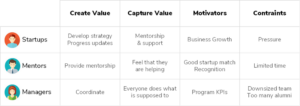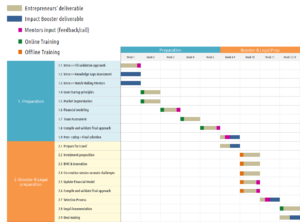COVID19 has accelerated online consumption in an unprecedented way, and shifted many activities to the digital space: e‐grocery, e-learning, entertainment, banking, events, etc.
Since organizing workshops, mentorship sessions around a coffee, and demo-days became impossible, startup incubators and accelerators also had to swap their preferred face-to-face interaction for online tools, which 70% of interviewed managers found no use of up until 2019.
Most programs opted to go fully online, and even if program managers recognized the process was difficult, more than 90% of 200 respondents in our survey noted that it was worthwhile. Why?
Accelerator managers had 3 realizations:
1. They were doing a poor job at leveraging online… the whole online interaction (before COVID19) was disorganized, and often based on unrealistic expectations.
2. Online will never fully replace offline interaction… one can’t create the same trust relationship and bond among participants via Zoom calls.
3. Blended models are the future… when the pandemic will be over, programs will be capable to balance more wisely online and offline interactions. Going digital also means accepting many more startups from around the world, instead of a limited number offline – a true international expansion.

1000 ways to get your online transition wrong
How do you transform your innovation network into a thriving community growing forward?
Is it enough to invite all your innovators, mentors, investors in a facebook group, so that they can connect, collaborate, and learn from each other? Only if your goal is to create a digital graveyard.
- It’s definitely not enough to have everyone connected in a digital space to achieve high engagement goals.
- It’s not even about the digital tool that you are using. Tools are just empty boxes, and it’s up to you to decide how people should fill them with relevant content.
Resistance to change is the real nightmare in this new context. We can become obstinate when asked to do something new, especially in cyberspace.
After 7 years of experimenting with blended accelerator models, combining online and offline, we have developed a 9-step framework to design program engagement strategies that work, and make you stand a chance against resistance to change.
Every engagement strategy includes a very important component of Human-centered design, to account for the needs and challenges of the different stakeholders involved. It then becomes clear that copy-pasting an engagement model applied in one program to another would be pointless, as each has different participants, with specific goals and needs. Here’s how we tackle this challenge:
1. Define the key goals
…beginning with the end in mind.
What is your program trying to achieve online?
Do you want to improve the availability and quality of mentorship? Make best-practices readily available? Foster peer-learning and collaboration? Engage external stakeholders? etc.
Be specific. List your goals, order them by priority, and clarify how these goals will marry the offline interaction in the program. Any overlapping between online and offline activities will frustrate your participants.
2. Map your stakeholders
List all the stakeholders who wish to engage: e.g. entrepreneurs, mentors, industry experts, investors, corporate partners, alumni, etc.
Ask your-self:
a. how can they create and capture value in the process? List all the activities that come to mind, and order them by priority.
b. what are their intrinsic and extrinsic motivators? E.g. Perhaps you don’t pay mentors (= no extrinsic motivators) but matching them to the right entrepreneur is enough for them to feel they have an impact (= intrinsic motivator) thus, getting the match wrong, will be recepe for disaster.
c. what are their main constraints? Time and motivation are the most recurring answers, but you may be surprised by what you may discover if you do a research across your network. Being aware of your stakeholders’ constraints will spare you the pains of putting forward an unrealistic, impossible-to-follow plan.
3. Minimum Viable Interaction
By now, you should have a clear idea of how each stakeholder plays a role in achieving the goals defined in step 1. You are finally ready to design the user-journey for each stakeholder group: the list of activities that you expect people to do, in order to fullfill their mission within the program.
You want to capture all types of activities, independently if they happen online and offline.
E.g. for Entrepreneurs: attend workshop (offline), book time with meet mentor (calendly) and have mentorship session (offline or Zoom), update the business strategy (Babele), Join thematic discussion on workshop’s topic, provide feedback to peer entrepreneur, etc.
However, it’s not enough to have a long list of activities that you ideally expect people to do weekly… you need recognize that, you can’s expect everyone to be equally motivated / tech-savvy, so if you treat everybody in the same way, it will be recipe for disaster. In every program, you get a range of more or less motivated participants. These are the extremes:
- Innovators: they are timely, trustworthy, proactive, learn fast, and they are a pleasure to work with.
- Laggards: they require continuous follow-up, they struggle at doing the most basic things, they are a pain in the ass.
There is no program with just innovators… you always get a distribution of more or less motivated entrepreneurs, mentors, and other stakeholders.
Programs that create overly-ambitious To-Dos for their participants, end-up losing many of them on the way. This is the same thing that happens when school teachers explain for the average students, and they lose both the best ones and the dunces.
The key to success is to tailor the user-jouneys, so that each person can contribute to the process based on their capability and their motivation to do so.
In other words, you need to identify the Minimum Viable Interaction (MVI).
In our accelerator program, the mentors’ MVI consists in:
- Organize a weekly mentorship session with their mentee;
- Wrap-up their coaching note online. That’s it.
When does the MVI comes into play?
During the onboarding. At first, your stakeholders should only be presented their Minimum Viable Interaction: the simplicity of the approach will make the onboarding sound easy, and sedate their resistance to change. After a couple of weeks from the start of the program, you will be immediately able to discern innovators, majority and laggards.
- You can ask to your Innovators to do all the things that you dreamt of in your ideal user-journey: they have the skills and the motivation to take on all of it;
- You can add some complexity, little-by-little to the majority of participants;
- You keep insisting on the Minimum Viable interaction with the laggards: you know very well that they will fail to do whatever additional task, so why bother? Make sure they stay focused on the few important things and let the social dynamic play its role…
…with such a tailored facilitation, you will get more people to naturally evolve towards higher states of motivation, as nobody likes to be missing out on opportunities.
4. Perfect your Timeline
A major mistake with online engagement is to work with indefinite cycles. There is not such a thing as on-going unlimited engagement … maybe for Netflix, but not for an online entrepreneurship community.
Engagement works best with definite timelines: with a START and an END date, as well as clarity of what each person is supposed to do, when and how.
It helps people to evaluate the effort they are required to put and take a serious commitment.
e.g. if you ask me: “can you please mentor me, 1 hour per week, over 8 weeks“, I can very easily estimate the effort and organize myself to make it happen. On the other hand, if you invite me to a mentorship group and I am supposed to do things whenever I feel, most likely, I will never find the time to do anything.
Another major mistake that many programs do is to have a perfectly clear calendar for the offline events, workshops and mentorship sessions, and no clarity whatsoever on the online tasks.
It’s key to create a holistic roadmap that captures all the activities per stakeholder-group, both online and offline (so that engagement becomes a continuum across different media used to run the program).
Such a roadmap is fundamental, as it enables to minimize the uncertainty of what a person is supposed to do at any point in time… Uncertainty kills engagement.
- The calendar should be built and validated in close cooperation with the key stakeholders (to avoid last minute surprises);
- The calendar is the reference document for the community facilitator, who will be able to follow-up on people and make sure that all goes smoothly and by the plan.
5. Test your assumptions
The onboarding process in whatever tool you are using, could easily transform into a nightmare. Many programs decide to onboard ALL stakeholders at the same time: entrepreneurs, mentors, investors, experts… This is usually recipe for disaster… as you end-up testing, validating, and firefighting with multiple user journeys at the same time.
Onboarding needs time, so people can digest what they are supposed to do and test their Minimum Viable Interaction. If something goes wrong, you can adjust a user journey for a stakeholder group, before you start onboarding the rest of the users.
We usually begin by piloting the whole community dynamic with a sub-set of participants from the community. Your goal should be to validate the engagement strategy, pre-populate the site activity with “inspiring examples” and define the “behaviour model” that you want to scale across future members. This is how you do it:
- Invite an alumnus to go through the framework and develop a champion venture profile (an exemplary project for everyone to understand how the final result should look like).
- Onboard all mentors, and ask them to interact with the only 1 venture in the online platform (you could not make it easier for them). You will immediately spot your innovators and laggards, and assess some steps in your user journey that could work better / be simplified.
- Finally, pre-create all the venture profiles and invite all entrepreneurs to join their startup… in this way, you minimize the friction and they can start working right away.
Give yourself at least 1 month to manage the onboarding: you will thank yourself later.
6. Facilitation done right
The facilitation process is like the yeast to bread.
It’s almost impossible to create an online entrepreneurship community and hope that things can work in autopilot, without the need of coordination. Even if you are using a web-platform with automatic reminders, these will never be as powerful as a human being with whome participants can relate and empathize.
The coordinators should have their own user-journey, so they know when and how to share updates, communicate with groups or individuals, and have a contingency plan in case something is not going as expected. Program facilitators that rely on improvisation often end up doing a poor job, and the engagement is the first thing that will fall.
Also, our recommendation for program managers is “get rid of the bad apples!” Some people may simply be the wrong fit for the program, and any effort to engage them is a waste of time. In our accelerator, we give our-selves 4 weeks from start of the program, to kick-out those Startups whose attitude is not in synthony with the program… it’s never too late to acknowledge that, what seemed good after a few interviews, may not be a relationship worth investing.
7. Don’t track everything, but SMARTLY
What you can’t measure, you can’t manage. You need information to know whether your online community is performing, so you can keep adjusting things through short and iterative cycles. Nobody gets it right at first, simply because you are instauring a behavioural model, and that takes time.
In particular you need quantitative information (e.g. whatever measurable through online tools: # comments, # connections, posts, etc.) but also qualitative information (forms and interviews for entrepreneurs, mentors, etc. to make sure that the relationship with the other stakeholders is going well and they can keep-up the pace of their user journey).
Choosing the right way to track progress and performance is fundamental. Let’s take a classic example:
What does it make sense to track?
As a program manager, I don’t care if mentors and entrepreneurs spoke at 1pm or 2am in the morning. So, I don’t need to see a clattered calendar, listing the conf-calls’ dates and times – as it wouldn’t tell me anything of what has been discussed and the quality of the conversation.
After that Mentors-mentees’ session take place, we ask mentors to wrap-up their coaching notes in the online platform. In this way:
- Entrepreneurs have a written trace of the coaching notes;
- It marks the beginning of a conversation between the entrepreneur and the mentor on that specific topic;
- The program manager gets a cleares picture of the job-quality that each mentor is doing;
- The coaching note could be made available also to other program participants, fostering peer-learning and knowledge transfer.
Measurement is at the base of Learning, and your learning objectives should be aligned with your program’s goals, established in step 1. Thus, rather than measuring too much, make sure you are after the right information.
8. Communication is KING
Communication is the key element that influences the most your engagement results. Through clear and effective communication:
- you create the right expectations for what participants are supposed to do;
- you foster excitement, and provide a smooth onboarding process;
- you make the onboarding and facilitation process efficient and to the point;
- you get ideas and feedback on how to improve your engagement strategy;
Communication is king throughout the process.
9. Managing alumni
What happens after that the program ends? You create your alumni network!
In this case there is no end date, as people remain alumni until the end of time, thus you need a CYCLE.
You can’t expect alumni to do things all the time: that’s unreasonable. That’s why the engagement strategy for your alumni network must be different that the one that you created for your accelerator program.
Within a cycle (let’s say 1 year long) you can create different call to actions for people to engage. E.g.
- Once every 2 months, you can do a call for the hottest entrepreneurs challenges, and catalize your network of mentors to help out. The startup in return would update their profile, and share a thorough progress and performance update.
- Twice per year, you can do a call for startups looking to raise funds. Those interested, will update their investment memorandum, which will be submitted to the investors.
- Once per year, you can do the same for corporations interested in scouting startups. The entrepreneurs interested to get in touch with a company, will update their profile.
Not everyone will participate every time, and that’s just fine. You just want to provide different opportunities for people to engage organically.
Conclusion
Yes, the transition to online entrepreneurship ecosystems is painful and full of unknowns, but if done well, in a year from now (once COVID will be a memory of the past), we will have incubators and accelerators more capable to wisely combine online and offline activities, as well as develop user journey that they will know how to facilitate and that people will be happy to follow.
The secret is not in how many features your platform has, and even the fact of using multiple platforms (Zoom, Babele, Slack, Mural, etc.) can be easily managed, with the right engagement strategy.
Finally, investing in behavioural modeling and tailoring the facilitation is key to leverage everyone’s potential instead of expecting the same behavior and motivation from everybody.
By Emanuele Musa









